Yay! It’s tree planting time again!
It’s cooler, the sun not so strong, making the winter months the time to buy more trees!
Consider planting one of the Valley’s old standards — not only to benefit your yard and attract birds and butterflies — but to promote a healthy native habitat.
Before you read further, take note of two important dates — 119th annual Christmas Bird Count — January 5, 2019 — contact Norma Friedrich, acaskiskadee@yahoo.com or call 361-676-6416 if you want to participate — this is a really fun time with experienced birders.
The second date to note on your calendar is for the 22nd GBBC — Great Backyard Bird Count — February 15-18, 2019. For more info: https://BirdCount.org.
Back to Tree Planting Time:
These first five trees listed are historic stand-alones — they will eventually take up considerable space.
Texas Ebony, Chloroleucon ebano, can grow to 50 feet tall. Host plant to sulfur, blue and skipper butterflies — provides cover for wildlife and nesting sites for birds; branches have paired spines.

Anacua, Ehretia anacua, moderate growth rate and can reach 15 to 40 feet in height. Dense canopy gives shelter and nesting for birds. Fragrant blooms in spring and after rain provide nectar for butterflies and bees and fruit for birds and critters.

Honey mesquite, Prosopis glandulosa, grows to 20 to 30 feet, relatively fast-growing. Its crooked, sprawling growth pattern adds an artistic element to the landscape. It flowers spring through summer. Young branches can have long, sharp thorns; older branches lose their thorns.

Brasil, Condalia hookeri, often reaching to about 15 feet, has small, light green, spatulate leaves and dense canopy. Branches end in a sharp spike. Protection for roosting and nesting birds; blooms summer and fall; fruit is popular with wildlife.
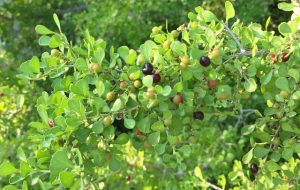
Guayacán, Guaiacum angustifolium, like mesquite, will define its own unique shape. Very slow growing, eventually reaching to 20 feet. Lavender orchid-like flowers bloom in spring and after rain. Excellent cover for wildlife; host to lyside sulphur and gray hairstreak butterflies.

Not so prevalent as the old standards, but certainly worth considering, are five unique native trees that belong to the Rutaceae family.
Two characteristics of Rutaceae family plants are that they “often feature aromatic leaves with oil glands on the surfaces . . . , and the flowers are conspicuous for their color, fragrance and nectar,” according to an online version of Britannica.com.
Citrus trees also are members of Rutaceae family, as are the herbs rue and bergamot. Most species in the family, though, are trees or shrubs.
Five trees easily grown in gardens in the Valley are:
Barreta (Helietta parvifolia); colima (Zanthoxylum fagara); esenbeckia, also called limoncillo – little lemon, and Runyon’s Esenbeckia (Esenbeckia berlandieri [E. runyonii]); Texas torchwood (Amyris texana); and Sierra Madre torchwood (Amyris madrensis).
These trees are listed on pages 375-377 of the Dr. A. Richarson/K. King, Plants of Deep South Texas book.
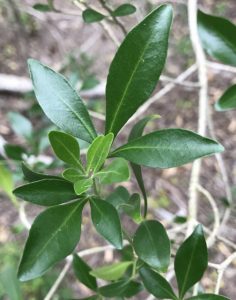

Barreta, colima and both species of torchwood are host plants for giant swallowtail butterflies. Orange, lemon, lime and grapefruit citrus trees also are hosts to species of swallowtails and the sickle-winged skippers.
The foliage on these five trees is sturdy, shiny and waxy-looking and gives off a citrusy-smell when crushed. White bloom clusters pop out in spring followed by small berries, which make these trees important to our native habitat for nectar and pollen from the flowers, and for food for birds and critters from the fruit.
Those same traits make any of these trees a fun addition to a garden. They have varying bloom times. Colima blooms in spring and after rainfall at other times during the year. The torchwoods bloom spring through fall; esenbeckia, spring and fall; and barreta blooms spring and summer.
Barreta and colima are listed as shrubs. Don’t let that fool you — barreta may be considered a shrub, but it can grow to 13 feet tall and sport a hefty girth. Colima can grow from 15 to 30 feet tall, depending how crowded it is with neighboring trees and vegetation, which also can lend it to a rather gangly growth pattern. Colima has a moderate to slow growth rate.
Of these five Rutaceae family trees and shrubs, colima is the only one armed — aggressively so, I might add. It has wicked, cat-claw-like sharp prickles — on both the branches and the trunk. Nevertheless, it’s a lovely tree with bright green leaves and an airy canopy.
Both torchwoods are small trees. Texas torchwood is the smaller of the two, growing to six feet, Sierra Madre to 10 feet. Torchwoods have slender, upright growth making them an attractive grouping when planted together.
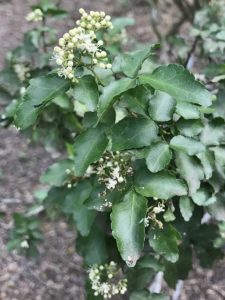

Esenbeckia, like barreta, needs plenty of space. It can grow to twenty feet tall. The canopy branches out in a wide “V” shape which allows it to support lower-growing understory.
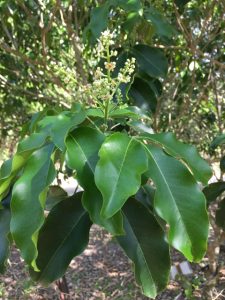
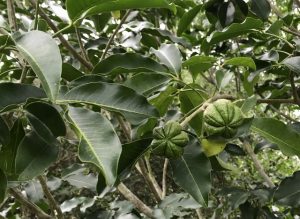
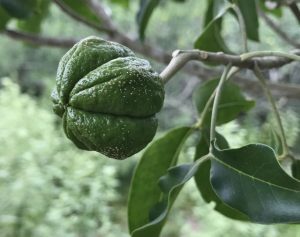
The leaves are larger than the other four trees in this group. They call to mind the leaves of an ornamental schefflera tree, also known as umbrella tree.
Esenbeckia seedpods are unusual — large green, round, segmented capsules about one and three-eighths inches across. The seedpods aren’t noticeable until you look for them.
Check out the previous post about Surprises on Ebony Loop — https://rgvctmn.org/anitas-blog-surprises-on-ebony-loop/
Plant the trees discussed in this post in full sun. When planting any tree, free the roots so they can spread in all directions, especially if they have become pot-bound and have circled around themselves. Dig a hole twice the size of the pot. Flood it with water and let drain before planting the tree.
After the hole has drained, plant the new tree at the height the soil level was when it was in the pot — or a bit higher, to allow for sinkage if the soil is very friable under the plant.
Fill in around the sides with loose, friable soil or purchased compost or a topsoil mix. Tamp down well to alleviate any air pockets. Water in well and water two to three times a week for about the first three weeks to make sure the plant becomes established. If you mulch around the tree, leave at least three inches of bare soil all around the tree trunk.
The Rutaceae family trees listed in this article can be purchased from Harlingen native nurseryman, Mike Heep. Please call 956-457-6834 prior to visiting.
Before you visit, perhaps you’d like to check out how Mike Heep helped reestablish, and continues to propagate, Texas’ rarest tree, Runyon’s Esenbeckia.
https://www.tamuk.edu/artsci/biology/herbarium/teaching%20garden/Limoncillo.html
https://texasforestservice.tamu.edu/websites/FamousTreesOfTexas/TreeLayout.aspx?pageid=26886
All trees mentioned in this posting can be seen around Ebony Loop in Harlingen’s Hugh Ramsey Nature Park.
Free guided native plant walks are available in the nature park:
Master Gardener and Texas Master Naturalist native plant experts lead walks first Friday and third Saturday of each month through May. No reservations required. Meet in the park’s parking lot at 9 a.m. for a two-hour walk along a level quarter-mile trail.
Hugh Ramsey Nature Park is located at 1000 South 499, north of the Arroyo Colorado River Bridge on North Ed Carey Drive, or two miles south of Harlingen International Airport.
